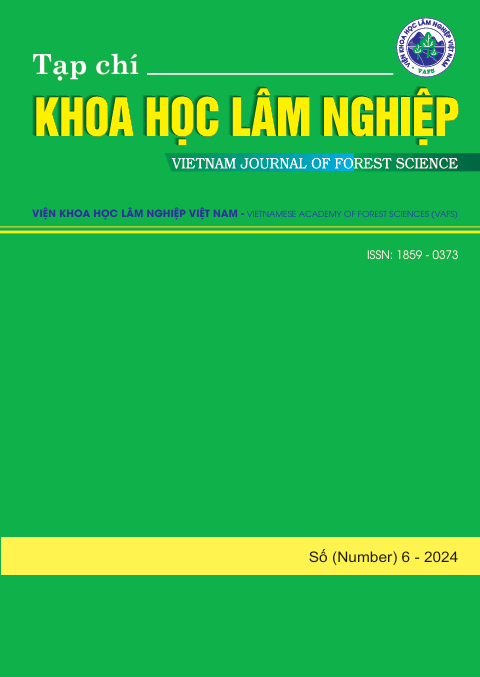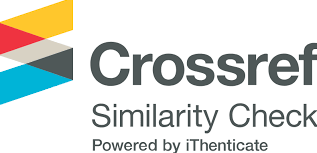RESEARCH ON DIVERSITY OF FOREST TREE SPECIES AND PROPOSE THE SOLUTIONS TO PRESERVE BIODIVESITY IN NATRUAL RESERVE MUONG LA, SON LA PROVINCE
DOI:
https://doi.org/10.70169/VJFS.979Keywords:
Conservation, Biodiversity, Flora, Muong La.Abstract
The results of additional surveys on plant diversity in Muong La nature reserve, Son La province have recorded 1,015 plant species, belonged to 5 plant phyla (Lycopodiophyta, Polypodiophyta, Equisetophyta, Pinophyta, Magnoliophyta). Recorded 10 families with a large number of species were Euphorbiaceae, Asteraceae, Poaceae, Fabaceae, Caesalpiniaceae, Fagaceae, Annonaceae, Dryopteridaceae, Rubiaceae, and Orchidaceae. The plants species were distributed in 8 habitat types including natural forest, plantation forests, shrublands, bamboo glades, grasslands, agriculture, residential and water areas. Plant species living in 5 basic life forms include upper buds, ground-close buds, semi-hidden buds, hidden buds, and annual buds. The research results also recorded 21 species belong to the IUCN Red List (2020), 31 species in the Vietnam Red Book, and 56 species in the Decree No.84/ND-CP (2021). The study has also evaluated the main threats to biodiversity in the study area and recommended 4 main solution groups to sustainably preserve biodiversity for Muong La nature reserve.
References
Bộ Nông nghiệp và Phát triển nông thôn, 2019. Nghị định 06/2019/NĐ-CP, Quản lý động vật rừng, thực vật rừng nguy câp, quý, hiếm và thực thi các công ước quốc tế về buôn bán quốc tế các loài động vật, thực vật hoang dã nguy cấp. Bộ Nông nghiệp và Phát triển nông thôn.
Bộ Nông nghiệp và Phát triển nông thôn, 2024. Quyết định số 816/QĐ-BNN-KL, ngày 20/3/2024; Công bố hiện trạng rừng toàn quốc năm 2023.
Bộ Khoa học và Công nghệ, Viện Khoa học và Công nghệ Việt Nam, 2007. Sách Đỏ Việt Nam. Phần II. Thực vật. Nxb. Khoa học tự nhiên và Công nghệ, Hà Nội.
Đỗ Tất Lợi, 2006. Những cây thuốc và vị thuốc Việt Nam, Nhà xuất bản Y học, Việt Nam.
Lingaraj Patro, 2010. Biodiversity conservation and management, Discocery Publishing House, New Deli, India. ISBN 978-81-8356-600-1.
Morse & Henifin, 1981. Rare plant conservation: Geography Data Organization, New York Botanical Garden, ISBN-13: 978-0893272234.
Shackleton, 2011. None timber forest products in the global context, Tropical Forestry, Spinger.
Sở Nông nghiệp và Phát triển nông thôn, tỉnh Sơn La, 2015. Đề án xác lập khu bảo tồn thiên nhiên Mường La.
The IUCN, 2019. Red List of Threatened Species. IUCN, Gland, Switzerland.
Trần Đình Lý,1993. 1900 loài cây có ích ở Việt Nam, Nxb Thế giới.
Võ Văn Chi, 2012. Từ điển cây thuốc Việt Nam, Tập 2, Nxb Y học, Hà Nội.
WWF Vietnam Country Programme. 2008. Vietnam High Conservation Value Forest Toolkit. Hanoi. WWF Vietnam Country Programme.
Trần Công Khánh, Phạm Hải, 2004. Cây độc ở Việt Nam, NXB Y học, Hà Nội.
Nguyễn Nghĩa Thìn, 2007. Các phương pháp nghiên cứu thực vật, NXB ĐHQGHN, Hà Nội.
Raunkiaer C., 1934. Plant life forms, Claredon, Oxford.
Lê Trần Chấn (chủ biên), Trần Tý, Nguyễn Hữu Tứ, Huỳnh Nhung, Đào Thị Phượng, Trần Thúy Vân, 1999. Một số đặc điểm cơ bản của hệ thực vật Việt Nam, Nxb Khoa học & Kỹ thuật, Hà Nội









